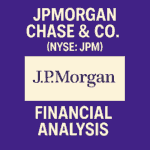Bank of America Corporation (NYSE: BAC)
Q2 2025 Financial Analysis | July 16, 2025
Executive Summary
Bank of America delivered solid Q2 2025 results, reporting net income of $7.1 billion, or $0.89 per diluted share, compared to $6.9 billion, or $0.83 per diluted share in the prior year. Revenue increased 4% year-over-year to $26.5 billion, driven by net interest income growth of 7% to $14.7 billion, marking the fourth consecutive quarter of sequential NII growth. The bank demonstrated strong operational performance with deposit growth of 3% to $1.97 trillion (8th consecutive quarter) and loan growth of 7% across all business segments, while maintaining excellent asset quality and returning $7.3 billion to shareholders.
Q2 2025 Highlights
Financial Performance
Bank of America’s Q2 2025 financial performance demonstrated strong momentum across key metrics. Net income of $7.1 billion increased 3% year-over-year, while diluted earnings per share of $0.89 represented a 7% improvement, benefiting from continued share repurchases that reduced the share count by approximately 2.5%.
Revenue growth of 4% to $26.5 billion was driven primarily by higher net interest income, which increased 7% to $14.7 billion, marking the fourth consecutive quarter of sequential NII growth. This improvement reflected fixed-rate asset repricing, higher NII related to Global Markets activity, and deposit and loan growth, partially offset by the impact of lower interest rates.
Operating leverage remained positive as revenue growth of 4% outpaced expense growth. Noninterest expense increased 5% to $17.2 billion, driven by higher revenue-related expenses and investments in people, brand and technology, but declined $587 million from Q1 2025 primarily due to the absence of seasonal payroll tax elevation.
Asset quality remained robust with net charge-offs stable at $1.5 billion for the sixth consecutive quarter. The provision for credit losses increased modestly to $1.6 billion from $1.5 billion in both Q2 2024 and Q1 2025, reflecting a small net reserve build of $67 million as the bank maintains prudent credit reserves.
The bank’s profitability metrics remained strong with a return on average common shareholders’ equity of 10.0% and return on average tangible common shareholders’ equity of 13.4%, demonstrating efficient capital utilization and strong earnings generation capability.
Business Segment Performance
| Business Segment | Net Income ($M) | YoY Change | Revenue ($M) | YoY Change | Key Metrics |
|---|---|---|---|---|---|
| Consumer Banking | $2,973 | +15% | $10,813 | +6% | 175K new checking accounts |
| Global Wealth & Investment Management | $993 | -3% | $5,937 | +7% | $4.4T client balances (+10%) |
| Global Banking | $1,699 | -20% | $5,690 | -6% | $603B deposits (+15%) |
| Global Markets | $1,528 | +8% | $5,980 | +10% | Sales & trading +14% |
Consumer Banking delivered outstanding performance with net income of $3.0 billion, up 15% year-over-year. The segment added approximately 175,000 net new consumer checking accounts, marking the 26th consecutive quarter of growth. Revenue increased 6% to $10.8 billion, driven primarily by higher net interest income. The segment now serves 38.2 million consumer checking accounts, with 92% being primary relationships.
Global Wealth and Investment Management generated net income of $1.0 billion with revenue increasing 7% to $5.9 billion. The growth was primarily driven by asset management fees, which increased 9% to $3.6 billion on strong AUM flows and higher market levels. Client balances reached $4.4 trillion, up 10%, driven by higher market valuations and positive net client flows of $14.3 billion.
Global Banking reported net income of $1.7 billion, with revenue declining 6% to $5.7 billion, reflecting lower net interest income, leasing revenue and investment banking fees, partially offset by higher treasury service charges. Average deposits increased a strong 15% to $603 billion, while the segment maintained its #3 investment banking fee ranking year-to-date.
Global Markets showed strong momentum with net income of $1.5 billion, up 8% year-over-year. Revenue increased 10% to $6.0 billion, driven by sales and trading revenue growth of 14% to $5.3 billion, marking the 13th consecutive quarter of year-over-year growth. Both FICC (up 16%) and Equities (up 10%) delivered solid performance.
All segments demonstrated loan growth, with the corporation achieving 7% average loan and lease growth to $1.13 trillion. The diversified business model continued to provide stability and growth across different market conditions and client needs.
Balance Sheet Strength & Capital Management
Bank of America maintained exceptional balance sheet strength with robust capital levels and strong liquidity positions:
Capital Position
- CET1 Capital: $201 billion, maintaining an 11.5% CET1 ratio under the Standardized approach, well above regulatory minimums
- Book Value per Share: Rose 8% to $37.13, with tangible book value per share increasing 9% to $27.71
- Tangible Common Equity Ratio: Strong at 6.1%, demonstrating solid capital efficiency
- Regulatory Compliance: All regulatory capital ratios remained well above minimum requirements
The bank’s average deposit balances of $1.97 trillion increased 3%, marking the eighth consecutive quarter of sequential growth. This deposit growth reflects the strength of the bank’s customer relationships and market position, with particularly strong performance in Consumer Banking where deposits have grown 32% from pre-pandemic levels.
Liquidity Management
- Average Global Liquidity Sources of $938 billion provide substantial liquidity buffer
- Strong deposit franchise with stable, diversified funding base
- Conservative asset-liability management maintaining appropriate duration risk
- Balanced deposit mix across business segments supporting NII stability
The bank returned $7.3 billion to shareholders during the quarter, consisting of $2.0 billion in common stock dividends and $5.3 billion in share repurchases. Additionally, Bank of America announced plans to increase the quarterly common stock dividend by 8% beginning in Q3 2025, reflecting confidence in earnings sustainability and capital generation capabilities.
Average loans and leases grew 7% to $1.13 trillion, with growth across every business segment. This balanced loan growth demonstrates the bank’s ability to meet customer credit needs while maintaining disciplined underwriting standards and appropriate risk management.
Net Interest Income & Deposit Momentum
Bank of America’s net interest income performance represents one of the strongest competitive advantages, with NII growing 7% year-over-year to $14.7 billion, marking the fourth consecutive quarter of sequential growth.
NII Growth Drivers
- Fixed-Rate Asset Repricing: Continued benefit from higher-yielding assets repricing in the current rate environment
- Balance Sheet Growth: 3% deposit growth and 7% loan growth contributing to earning asset expansion
- Global Markets Activity: Higher NII related to increased trading and client activity
- Deposit Mix: Favorable deposit composition with strong checking account growth
The deposit franchise continued to demonstrate remarkable strength with the eighth consecutive quarter of growth. Consumer Banking added approximately 175,000 net new consumer checking accounts, bringing the total to 38.2 million accounts, with 92% representing primary banking relationships.
Digital Banking Leadership
- 49 million active digital banking users, representing 79% of households actively using digital platforms
- 4.1 billion digital logins, up 18% year-over-year
- 65% of total sales were digitally-enabled, demonstrating successful digital transformation
- 24.3 million active Zelle users, up 8%, processing 446 million transactions worth $139 billion
The bank’s deposit growth trajectory remained healthy across all business segments. Global Banking saw particularly strong performance with 15% average deposit growth to $603 billion, while Consumer Banking maintained stable deposit levels with improving mix toward primary checking relationships.
Net interest income momentum is expected to continue, supported by the bank’s asset-sensitive balance sheet positioning, continued deposit growth, and disciplined pricing strategies. The bank’s substantial deposit franchise provides a competitive moat and stable funding advantage in various interest rate environments.
Credit Quality & Risk Management
Bank of America maintained excellent asset quality metrics, demonstrating the strength of its underwriting standards and risk management practices:
Credit Performance Highlights
- Net Charge-offs: Stable at $1.5 billion for the sixth consecutive quarter, with a net charge-off ratio of 0.55%
- Consumer Credit Cards: Loss rate improved to 3.82% from 4.05% in Q1 2025, with both early and late stage delinquency rates declining
- Nonperforming Loans: Decreased to $6.0 billion from $6.1 billion in Q1 2025, representing 0.52% of total loans
- Allowance Coverage: Allowance for loan and lease losses of $13.3 billion represented 1.17% of total loans
Consumer credit metrics showed continued stabilization with consumer net charge-offs of $1.1 billion decreasing $60 million from Q1 2025, driven by lower credit card losses. The credit card portfolio showed improving trends with both early and late stage delinquency rates declining compared to both Q1 2025 and Q2 2024.
Commercial credit performance reflected selective charge-offs primarily related to sales and resolutions of commercial real estate office properties. Commercial net charge-offs of $466 million increased $133 million compared to Q1 2025, but remained within expected ranges given the current commercial real estate environment.
Reserve Management
- Total allowance for credit losses of $14.4 billion, including $1.1 billion for unfunded commitments
- Net reserve build of $67 million in Q2 2025, maintaining prudent reserve levels
- Commercial reservable criticized utilized exposure increased $252 million to $27.9 billion
- Provision for credit losses increased modestly to $1.6 billion, reflecting economic outlook adjustments
The bank’s credit risk management approach remains disciplined, with conservative underwriting standards and comprehensive monitoring systems. The diversified loan portfolio across consumer, commercial, and corporate segments provides natural risk diversification, while the bank’s scale enables sophisticated risk assessment and management capabilities.
Looking forward, Bank of America’s credit quality positioning appears strong, with stable loss rates, adequate reserve coverage, and improving consumer credit trends. The bank’s experience managing credit through various economic cycles provides confidence in its ability to maintain asset quality standards.
Strategic Initiatives & Outlook
Bank of America continues to execute on key strategic initiatives that position the company for sustained growth and market leadership:
Digital Transformation Leadership
- Mobile Banking Dominance: #1 ranking in Banking Mobile App Satisfaction with 49 million active digital users
- Erica AI Assistant: Continued expansion of AI-powered customer service capabilities
- Digital Sales: 1.9 million digitally-enabled sales representing 65% of total sales
- Zelle Integration: Market-leading position in P2P payments with 24.3 million active users
The bank’s responsible growth strategy focuses on deepening client relationships across all business segments. Consumer Banking added 175,000 net new checking accounts, while Global Wealth and Investment Management added approximately 7,100 net new relationships across Merrill and Private Bank.
Market Leadership Positions
- No. 1 in U.S. Consumer Deposits and Small Business Lending
- No. 1 in Retail Banking Advice Satisfaction and Mobile App Satisfaction
- #3 investment banking fee ranking year-to-date
- 13th consecutive quarter of year-over-year growth in Global Markets sales and trading
Bank of America’s commitment to environmental, social, and governance (ESG) initiatives continues with industry-leading sustainable finance capabilities and community development investments. The bank’s focus on supporting economic mobility and financial inclusion aligns with long-term value creation for all stakeholders.
Technology and Innovation
- Continued investments in cloud migration and data analytics capabilities
- Enhanced cybersecurity and operational resilience frameworks
- Advanced risk management and regulatory technology implementations
- Innovation in payments, lending, and wealth management platforms
Looking ahead, management expressed confidence in the bank’s positioning for continued growth, supported by the strength of the deposit franchise, disciplined expense management, and strategic investments in people, brand, and technology. The diversified business model provides multiple avenues for growth while maintaining financial stability and competitive market positions.
Risks & Opportunities
Opportunities
Risks
Conclusion
Strengths
- Strong NII growth (7% YoY) for fourth consecutive quarter
- Robust deposit growth for eighth consecutive quarter
- Excellent credit quality with stable charge-offs
- Strong capital position (11.5% CET1 ratio)
- Market-leading digital banking platform
Key Performance Drivers
- Diversified business model across four segments
- Industry-leading deposit franchise
- Disciplined expense management and operational efficiency
- Consistent capital return to shareholders
- Strong risk management and underwriting standards
Investment Summary
Bank of America delivered strong Q2 2025 results that demonstrate the effectiveness of its responsible growth strategy and the strength of its franchise positions. Net income of $7.1 billion and EPS growth of 7% reflected broad-based performance improvements across the diversified business platform.
The bank’s net interest income growth of 7% to $14.7 billion for the fourth consecutive quarter, combined with 8 consecutive quarters of deposit growth, highlights the competitive advantages of the deposit franchise and asset-sensitive positioning. Credit quality remained excellent with stable charge-offs and improving consumer trends.
With a strong capital position (CET1 ratio of 11.5%), robust liquidity ($938 billion in Global Liquidity Sources), and market-leading digital capabilities, Bank of America is well-positioned to continue generating sustainable returns for shareholders. The 8% dividend increase announcement and $7.3 billion in total capital returns demonstrate management’s confidence in the earnings trajectory.
The combination of deposit franchise strength, diversified revenue streams, disciplined risk management, and technology leadership positions Bank of America for continued outperformance across various economic environments.




